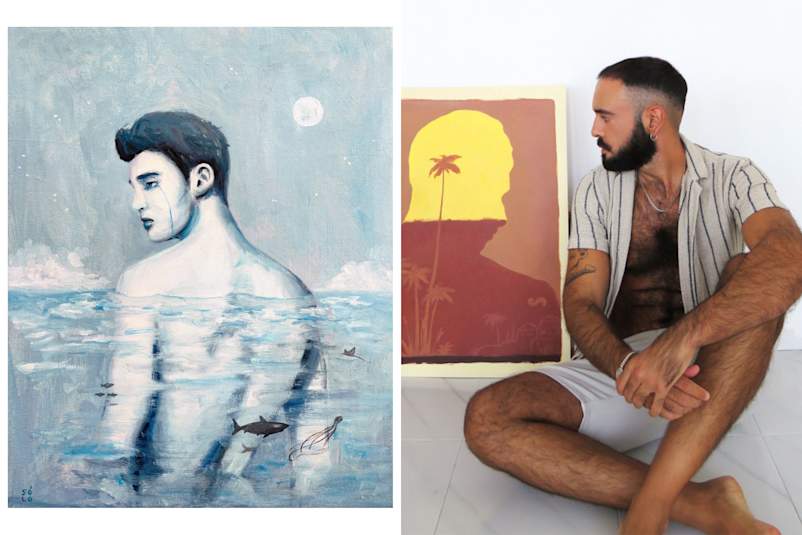The Queer Eyes of Bran Sólo

Diving into the vast array of blues in the artist Bran Sólo’s surreal landscapes evokes the invigorating smell of seawater or the anticipated post-coital melancholia that comes from lying in bed while watching a lover put on their clothes as they make their departure.
Sólo’s work often features crying fish and flying men who inhabit a world of blue that is so vivid that it appears to overflow from the canvas onto the mantel; or become oceans in miniature as seen from the vantage point of a playful partner taking in the quiet beauty of intimacy. While peering into his lush canvases, one can imagine standing over a bed, dazzled by their lover below, their only witness, a bright highlight; perhaps a plush toy sitting nearby―a memento mori in Pokémon form, or a hopeful wink with the promise of love yet to evolve.
Although he was born far from the ocean, in the town of Abarán―in the Spanish province of Murcia―Sólo’s work is filled with seaside dreamscapes, longing sailors, and saudade: the profound sense of yearning famously captured in fado. “I normally deal with heavy, dark emotions like fear, loneliness, and heartbreak,” said Sólo to TheBody. “They might not be the most important feelings, but they make us more vulnerable and human. They become elements that bring us together.”
The most striking quality about Sólo’s paintings is that they mirror queer male desire and longing. For instance, his portraits of men shedding tears that unite the sky and the ocean, or piercing pale blue eyes that pretend not to look at you. He believes in shifting our preconceptions of what society expects of men. “Being a man isn’t to not have feelings, be strong, courageous, protective, determined, and indestructible,” he explained. “Being a man can be fragile, emotional, fearful, mortal.”
Throughout his work, men are allowed to exist as fully emotional beings, who are unafraid to cry while being watched or love effusively by literally wearing their hearts on their sleeves. His recurring use of aquatic symbols is a soulful reminder that our molecular composition is mostly water, creating an undeniable sense of connection with the feelings expressed in his work. Sólo’s men aren’t categorized or separated by caste, race, ability, or serostatus: They are us, and we are them.
As a child, Sólo was obsessed with redesigning the world and was a keen explorer of fantasy, sci-fi, and the absurd. Tim Burton’s nightmarish scenarios provided early stimulation, as did work that went beyond vanilla “social human interaction.” Following that influence, the men in his oeuvre often look as if Rainer Werner Fassbinder showed up in Edward Scissorhands’ world. Sólo selects his subjects based on the feelings he sees in their eyes. As for the creation process, “I study my own feelings in comparison to others’ and compose images that lead me to reflect on my worries and see how that message connects to others,” he explained.

From the beginning, Sólo saw the world differently―he could detect people’s auras, which his “inner psychologist” learned to read and, upon reflection as an adult, led him to a magical world where nothing was impossible. “I could change things that couldn’t be changed,” he commented.
Though an art career might have seemed like a natural progression, he found himself stuck in a windowless office―working a 9-to-5 computer programming job that offered him financial security but stole his joy. Realizing that this was spiritually unsustainable, he enrolled in the Art School of Murcia, where he graduated with honors and received a scholarship to continue his studies in Porto.
While at school, he discovered his unique worldview was partly due to a case of central serous chorioretinopathy and a macular lesion―an eye condition that makes it impossible for him to see stars in the night sky. This came about after a professor asked his class to look at a red point on the whiteboard. Sólo, who was 27, couldn’t see it.
“I don’t have blurry vision,” he clarified. “The point simply wasn’t there.” Sólo realized his brain had been interpreting the world as if it were a unique painting all along. People’s faces were often covered in shadows, with their ears floating near their heads. Lights on a road could become rainbows just as wet pavement could look like an abyss. Although he’s had surgery since, Sólo still sees duplicate images and sometimes has a hard time visually narrowing details others are pointing to.
That unique perspective appears throughout his work in unexpected elements. For instance, in his painting, “Un Novio en Grana,” a single orange-ish leaf is suspended near the buttocks of a kneeling man. What could be a play on color contrast embodies the relentless passing of time while hinting at the possibility of the future.
Although Sólo’s use of color and imagery brandishes an otherworldly quality, it’s the urgency of his storytelling that stays with viewers. The artist has no romantic ideas of technique, and unlike artists who are precious about their medium, Sólo says, “thanks to my life in programming,” sometimes that means using technology and digital tools in his work. In “Moreno II,” for instance, he combines digital editing, hand drawing, and powder pigment printing to craft a strikingly modern piece that somehow wouldn’t feel out of place in an archeological exhibit.
Now in his mid-30s, Sólo makes “art all day but not every day”―as his sole profession―and has crafted a unique vision of the world that is inspired by understanding himself and those around him. Given that perspective, he said, “I’m not surprised most of my audience are LGBTQI+ men. By trying to connect with people through what I feel, I undoubtedly will end up finding other people like myself.”

